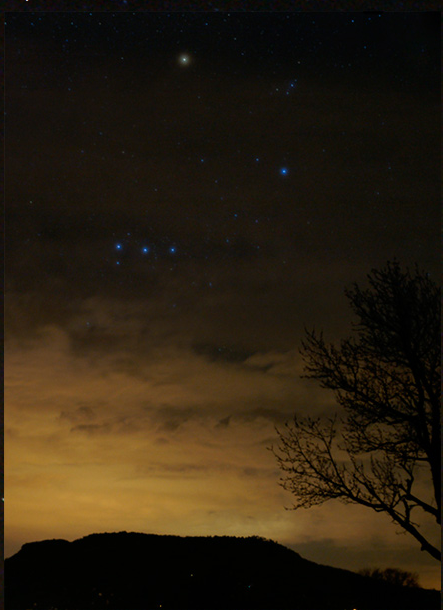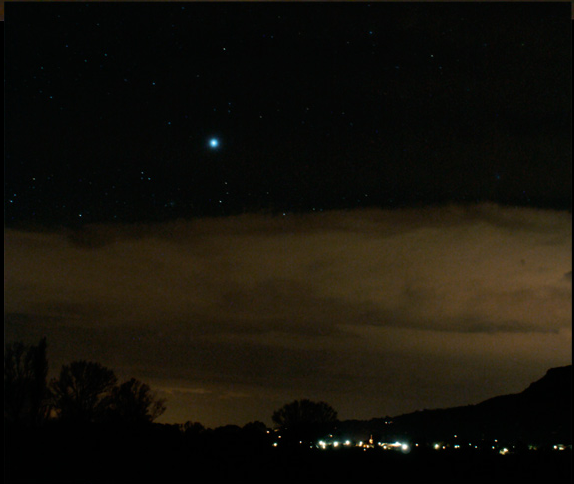Misty Hunter
Misty Hunter: Unveiling the Beauty of Atmospheric Optics
Have you ever gazed at the night sky and noticed a stunning display of colors around the stars? This phenomenon, known as an aureole or corona, is caused by water droplets in our own troposphere. The Misty Hunter, as it is sometimes called, offers a mesmerizing spectacle that captivates both amateur stargazers and professional photographers alike.
On the evening of April 1st, 2010, Monika Landy-Gyebnar ventured out to photograph the celestial wonders near Lake Balaton in Hungary. Little did she know that a cold front was approaching, threatening to obscure the stars with its impending cloud cover. However, before the clouds rolled in, Monika was treated to a breathtaking sight—a bright corona around the stars.
The corona acted like a diffuse filter, giving the stars a slightly fuzzy appearance and enhancing their colors. This natural phenomenon provided Monika with an opportunity to capture the true visible colors of the stars. She described it as "nothing special," but the sheer beauty of this atmospheric optical effect was undeniable.
Strictly speaking, what Monika observed were aureoles rather than coronas. In Hungarian, there is no distinct word for corona and aureole; both are referred to as "koszorú," meaning wreath due to their similar shape. The presence of an aureole or a ringed corona depends on factors such as brightness and the size distribution of the droplet scatterers.
Droplets with a wide range of sizes do not produce coronae because the rings they create overlap and become smeared away. The size of the glows around the stars in Monika's photographs is noteworthy. Comparing them to the Bishop's ring featured in a previous observation, it becomes apparent that these aureoles originate from droplets of vastly different dimensions.
Let's delve further into the Misty Hunter and explore the science behind this captivating atmospheric optics phenomenon:
-
Aureoles and Coronae: Aureoles are diffraction rings of light caused by the scattering of light through water droplets in the atmosphere. Coronae, on the other hand, consist of concentric colored rings around a central light source. Both phenomena are visually striking and add a touch of magic to the night sky.
-
Water Droplets: The presence of water droplets is essential for the formation of aureoles and coronae. These droplets act as tiny prisms, bending and scattering light to create the vibrant rings of colors. The size distribution of these droplets determines whether an aureole or a corona will be visible.
-
Size Matters: The size of the water droplets plays a crucial role in determining the appearance of the optical effect. Larger droplets tend to produce more prominent aureoles, while smaller droplets may result in finer, more intricate coronae. The interplay between droplet size and the angle of light creates a symphony of colors in the night sky.
-
Starlight's Journey: When starlight passes through Earth's atmosphere, it encounters countless water droplets. These droplets scatter the light, causing it to spread out and form the stunning rings we observe. The complex interaction between light and water droplets gives rise to the ethereal beauty of the Misty Hunter.
-
Variety of Colors: The colors observed in aureoles and coronae are not random but are determined by the physics of light. As white light passes through water droplets, it undergoes dispersion, separating into its constituent colors. This dispersion creates the vibrant hues that adorn the celestial wreaths.
-
Celestial Wonders: The Misty Hunter is not limited to specific stars or constellations. Any sufficiently bright celestial object can exhibit an aureole or a corona under the right atmospheric conditions. From the red giant Betelgeuse to the blue supergiant Rigel, and even the famous Sirius, these stellar gems become even more enchanting when adorned with their celestial wreaths.
The Misty Hunter is a reminder of the intricate beauty of our atmosphere and the wonders it can unveil. As we gaze upon the night sky, let us appreciate not only the distant stars but also the atmospheric phenomena that enhance their splendor. Next time you find yourself under a starry sky, keep an eye out for the Misty Hunter, for it is a sight that truly transcends the boundaries of Earth and sky.

Misty Orion ~ Images from Hungary on the evening of 1st April '10 by Monika Landy-Gyebnar.
Images ©Monika Landy-Gyebnar.
Red giant Betelgeuse at top is surrounded by a diffraction aureole created by water droplets in our own troposphere. As is the blue supergiant Rigel at right and Orion's three belt stars Alnitak, Alnilam and Mintaka.
"Yesterday evening we went out photographing around some extinct volcanoes near Lake Balaton. A cold front was to come and we only had a little time before its clouds appeared at the western part of our sky. These clouds had not only faded the stars, but before it happened most of the stars developed a bright corona. around them.
It had an effect like a diffuse filter that made the stars look a bit fuzzy and also make their colours more easily observable. There was nothing special in it, only beauty of a natural phenomena helping us to record the real visible colours of the stars."
.Strictly speaking they are aureoles, coronas have rings. But Monika says "We in the Hungarian language do not have a different name for corona and aureole, both are called "koszorú' (literally a wreath - for the similarity of shape)."
Whether there is an aureole or a ringed corona depends on its brightness (sometimes the rings are just too faint to be visible) or the size distribution of the droplet scatterers. Droplets with a wide range of sizes do not produce coronae because any rings are also of different size and so overlap and are smeared away.
Note the size of the glows around the stars compared with that of the Bishop's ring in the previous OPOD. Both are aureoles but from droplets of vastly different dimension.
At left: Sirius, Homer's 'star that flames at harvest', has its aureole.

Note: this article has been automatically converted from the old site and may not appear as intended. You can find the original article here.
Reference Atmospheric Optics
If you use any of the definitions, information, or data presented on Atmospheric Optics, please copy the link or reference below to properly credit us as the reference source. Thank you!
-
<a href="https://atoptics.co.uk/blog/misty-hunter/">Misty Hunter</a>
-
"Misty Hunter". Atmospheric Optics. Accessed on November 26, 2024. https://atoptics.co.uk/blog/misty-hunter/.
-
"Misty Hunter". Atmospheric Optics, https://atoptics.co.uk/blog/misty-hunter/. Accessed 26 November, 2024
-
Misty Hunter. Atmospheric Optics. Retrieved from https://atoptics.co.uk/blog/misty-hunter/.